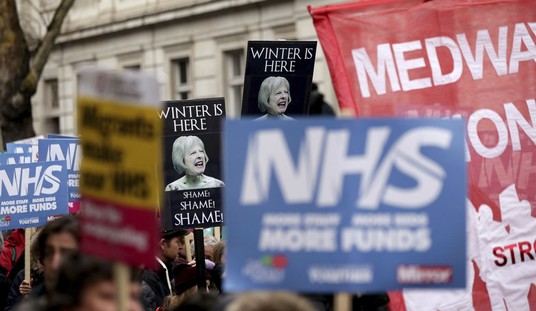After a poor outing in March, job creation rebounded in April as the US economy added 223,000 jobs. The official jobless rate dipped slightly to 5.4%, while the U-6 rate dropped to its lowest level since August 2008, just before the financial-sector crash:
Total nonfarm payroll employment increased by 223,000 in April, and the unemployment rate was essentially unchanged at 5.4 percent, the U.S. Bureau of Labor Statistics reported today. Job gains occurred in professional and business services, health care, and construction. Mining employment continued to decline.
In April, both the unemployment rate (5.4 percent) and the number of unemployed persons (8.5 million) were essentially unchanged. Over the year, the unemployment rate and the number of unemployed persons were down by 0.8 percentage point and 1.1 million, respectively.
March’s poor jobs report got revised downward even more sharply, to 85,000 from 126K. Not surprisingly, the labor force measures have still barely moved:
In April, the civilian labor force participation rate (62.8 percent) changed little. Since April 2014, the participation rate has remained within a narrow range of 62.7 percent to 62.9 percent. The employment population ratio held at 59.3 percent in April and has been at this level since January. (See table A-1.)
The number of persons employed part time for economic reasons (sometimes referred to as involuntary part-time workers) was little changed at 6.6 million in April, but is down by 880,000 from a year earlier. These individuals, who would have preferred full-time employment, were working part time because their hours had been cut back or because they were unable to find a full-time job. (See table A-8.)
The civilian labor force increased by 166,000 in April, so the overall gain was 67,000 jobs — not bad, but hardly enough to make a dent in the workforce participation rate. Discouraged workers and those marginally attached to the labor force both increased slightly in April, but remained relatively steady.
Of the 223,000 jobs added, all but 10,000 came in the private sector. The biggest additions were to professional and education and health services, adding 62,000 each. Construction added another 45,000. The big losers were mining and logging (-15K), wholesale trade (-14.5K), and durable goods manufacturing (-1K). Earnings remained mainly flat, up only three cents an hour and $1.04 a week.
It’s not a bad jobs report, but it’s not all that great either. A year ago, the 3-month average in private-sector job growth was 237K, a maintenance rate rather than a growth rate. This year, the average is 189K. We still aren’t growing, and what’s looking like contraction in Q1 is likely to keep job creation slow this summer.
The AP’s report isn’t exactly brimming with sunshine either:
Yet the report included signs of sluggishness … Oil and gas drillers, which have struggled under the weight of lower energy prices, shed jobs for a fourth straight month.
But in an encouraging sign, construction companies, which include many higher-paying positions, added jobs at a healthy pace in April.
The job growth isn’t yet boosting paychecks much. Average hourly wages rose just 3 cents in April to $24.87. Wages have risen 2.2 percent in the past 12 months, about the same modest year-over-year increase as in the past six years.
Reuters takes a more optimistic approach:
Still the solid report, which showed steady gains in hourly earnings, suggested underlying strength in the economy at the start of the second quarter after growth hit a soft patch at the start of the year.
The economy wobbled in the first quarter and may have even contracted as it was buffeted by bad weather, port disruptions, a strong dollar and deep spending cuts by energy firms.
Economists polled by Reuters had forecast payrolls rising 224,000 and the unemployment rate ticking down to 5.4 percent.
The Fed is likely to hold off tightening monetary policy for at least a few more months given the headwinds to growth from the dollar and spending cuts in the energy sector, and a desire among officials to get a firmer fix on the economy’s trajectory.
The problem is that we’ve been on the cusp of “strength in the economy” for six years of recovery. We never quite get there.







Join the conversation as a VIP Member